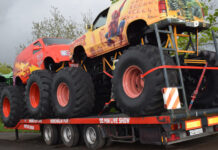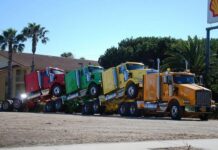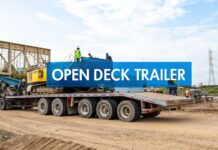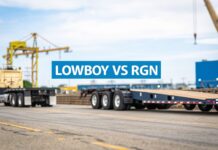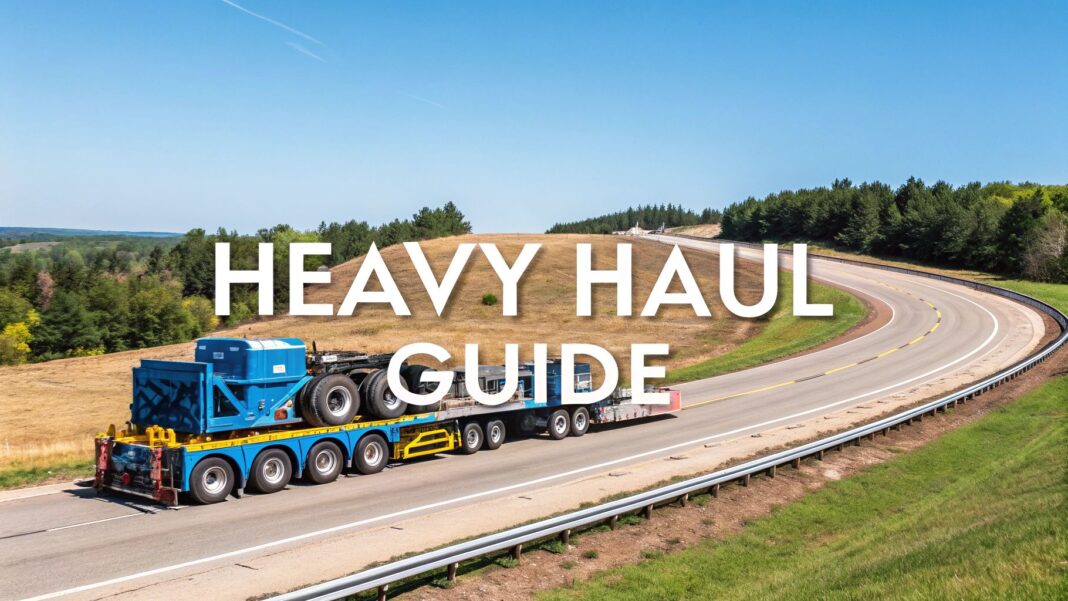
When you think of logistics, you probably picture standard shipping containers or pallets neatly stacked in a warehouse. Heavy load logistics is a different beast entirely. It’s the specialized art and science of moving cargo that’s too large, too heavy, or too awkwardly shaped to fit within standard legal limits for transport.
This isn't about simply getting something from A to B. We're talking about a highly coordinated mission to transport massive items like industrial machinery, bridge beams, or even entire modular homes. It’s a field where engineers, project managers, and specialized transport crews converge to make the impossible, possible.
Decoding the World of Heavy Load Logistics
Imagine the challenge: moving a 200-foot-long wind turbine blade through a town with narrow streets and low-hanging power lines. That’s the practical reality of heavy load logistics. While regular freight is all about speed and volume for standardized cargo, heavy haulage is a game of inches, pounds, and meticulous planning.
The primary difference lies in the cargo itself. Standard freight must stay under a gross vehicle weight of 80,000 pounds and fit within set dimensions. Any shipment that exceeds those limits is classified as an oversize or overweight load, which brings a completely new set of transport rules into play.
Beyond Just Weight and Size
Moving a colossal piece of equipment is less a delivery and more a massive project management challenge. You can't just book it online and expect a standard truck to show up. Every single heavy haul requires a custom-built transport plan from the ground up.
Here's what truly sets it apart and what you need to prepare for:
- Custom Route Planning: Forget Google Maps. Every inch of the transport route must be physically surveyed for obstacles like low bridges, sharp turns, or roads that can't handle the weight. This is a non-negotiable step for a successful move.
- Navigating Bureaucracy: Securing the right permits often means dealing with a complex maze of city, state, and sometimes federal transportation agencies. This process is a critical part of the project timeline.
- Specialized Fleets: Your typical flatbed won't cut it. This work calls for a whole different class of equipment, from multi-axle lowboy and removable gooseneck (RGN) trailers to incredible self-propelled modular transporters (SPMTs).
This work requires a unique blend of skills. A logistics professional in this field needs to think like an engineer to balance the load, a lawyer to navigate the regulations, and a risk manager to anticipate problems before they happen. To better understand these factors, you can find more details on heavy cargo weights and shipping services and see how different loads demand unique transport solutions.
Heavy load logistics is the art and science of moving the immovable. It transforms a logistical nightmare into a precisely executed engineering marvel, turning impossible transport challenges into successful deliveries.
Ultimately, the mission is to get incredibly valuable—and often one-of-a-kind—cargo to its destination safely and on schedule. This foundation of intense planning, strict compliance, and specialized knowledge is what defines heavy load logistics.
Your Strategic Blueprint for Heavy Transport
When it comes to heavy load logistics, the real work is done long before the engine starts. Success is almost entirely determined in the planning phase. Think less like a delivery driver and more like a military strategist; every variable needs to be calculated, and every potential roadblock needs a pre-planned solution. This is the bedrock of a heavy haul that’s safe, legal, and on schedule.
The absolute first step is the route survey. This is far more than just plugging addresses into a GPS. Experts will physically or digitally comb over every mile of the proposed journey, identifying critical details that standard navigation software would miss entirely.
Deconstructing the Route Survey
A route survey is a hands-on investigation to pinpoint and document every possible hazard. You’re looking for the details that could bring a multi-million dollar transport to a halt. The end goal is a fully vetted, pre-approved path that accounts for every inch and pound of your specific cargo.
A thorough survey digs into several key areas:
- Vertical Clearance Analysis: Measuring the height of every bridge, overpass, tunnel, and even low-hanging power lines to guarantee the load can pass cleanly underneath.
- Weight Capacity Checks: Confirming that every bridge and stretch of road on the route is rated to handle the gross vehicle weight, which can easily top 100,000 pounds.
- Horizontal Clearance and Turning Radii: Assessing tight corners, narrow lanes, roundabouts, and tricky city intersections to ensure the entire truck and trailer setup can maneuver without incident.
- Temporary Obstacles: Noting potential disruptions like construction zones, seasonal road restrictions, or local events that could derail the transport schedule.
This visual captures the essential workflow for a heavy haul, showing how specialized equipment, permits, and safety protocols all fit together.
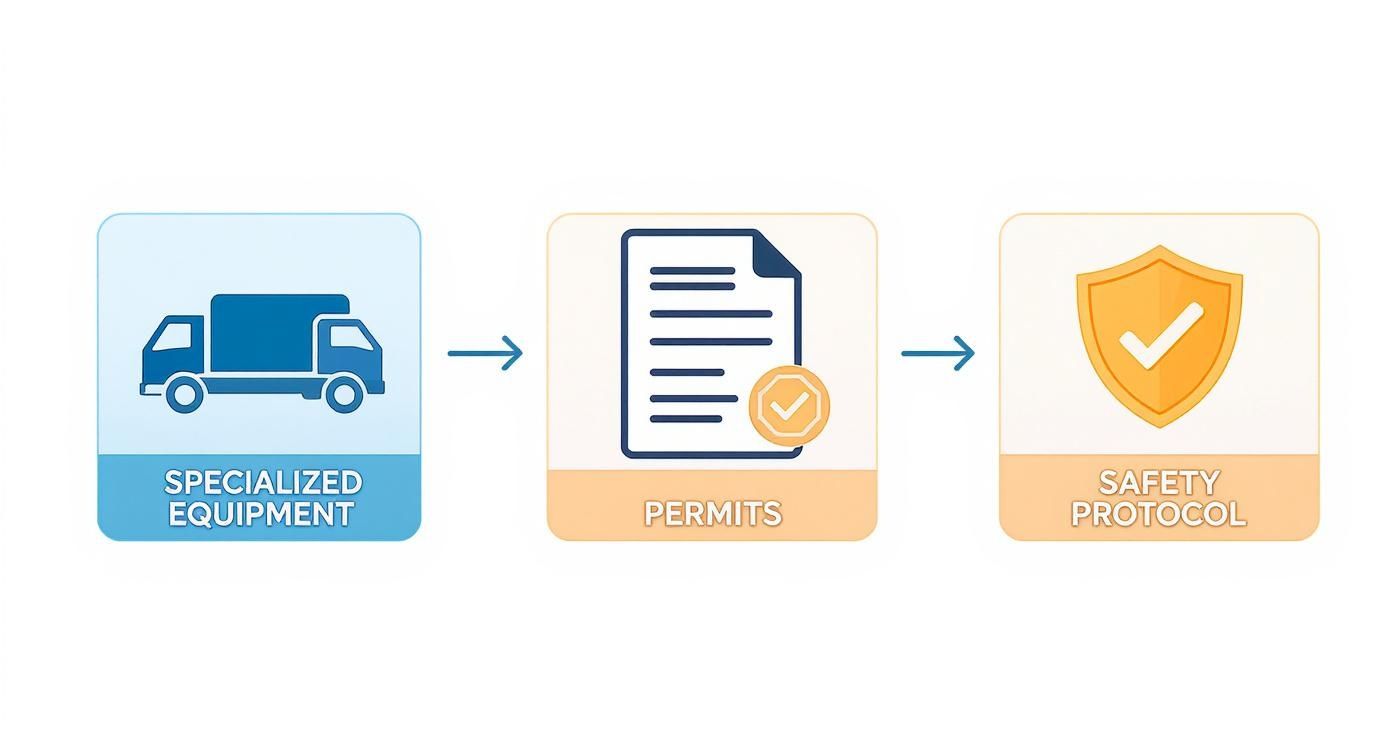
As the infographic shows, these three pillars—equipment, permits, and safety—aren't just a checklist. They are deeply interconnected parts of a single, cohesive transport strategy.
Navigating the Complex World of Permits
With a viable route mapped out, the next major hurdle is securing all the necessary permits. This is often the most frustrating and time-consuming part of the process because there's no national standard. A move that crosses just three state lines means you're dealing with three different sets of rules, applications, and processing times.
A classic rookie mistake is underestimating how long permitting takes. Some states might turn around an oversize permit in a couple of days. Others, especially for superloads, could take several weeks. You have to build that variability into your project timeline from the very beginning.
Permit applications demand absolute precision. You’ll need to provide exact cargo dimensions, gross weight, axle weights, and the specific route you plan to take. One small error can get your application rejected, forcing you to start all over and creating major delays.
Building Robust Contingency Plans
Even the most flawlessly planned transport can encounter unexpected problems. That’s why a contingency plan isn't a "nice to have"—it's a critical part of managing risk. A solid plan identifies potential issues and provides clear, actionable steps to resolve them.
An effective backup plan should include:
- Sudden Weather Changes: Heavy rain, snow, or high winds can make roads incredibly dangerous. The plan must identify safe, pre-determined locations where the driver can pull over and wait for conditions to improve.
- Unexpected Road Closures: An accident or emergency can shut down your primary route without warning. A contingency plan needs to include pre-approved alternate routes that have also been surveyed for clearances and weight limits.
- Mechanical Failures: What’s the protocol if the truck or an escort vehicle breaks down? The plan should outline communication procedures and have a list of nearby service providers capable of handling heavy-duty repairs.
Ultimately, this entire strategic blueprint is about one thing: control. By meticulously surveying the route, navigating the permit maze, and preparing for the unexpected, you transform a high-stakes operation into a predictable, manageable project. It’s this proactive approach that separates the pros from the amateurs.
Navigating the Maze of Transport Regulations
Moving an oversized load isn't just a matter of getting from point A to point B. It’s a journey through a dense thicket of local, state, and federal rules that dictate nearly every move you make. These regulations are in place for a good reason—to protect our roads and keep the public safe—but for anyone trying to ship a heavy load, it can feel like navigating a labyrinth.
The Federal Motor Carrier Safety Administration (FMCSA) provides the baseline. Typically, if your load is wider than 8.5 feet (102 inches), taller than 13.5 feet, or weighs more than 80,000 pounds, you're officially in "oversize" territory and will need special permits. But here's the catch: there's no such thing as a single, national oversize permit.
Instead, everything is handled at the state level. That means if your haul crosses three state lines, you need three different permits. Each one comes with its own set of rules, its own price tag, and its own timeline. You might get approval from one state in a day, while its neighbor could take weeks, especially if you're dealing with a "superload."
What You Need to Know About State-Specific Rules
Every state's Department of Transportation (DOT) plays by its own rulebook when it comes to permits, escort vehicles, and when you're allowed to be on the road. A load that’s completely legal in one state can instantly become a violation the second it crosses the border. This is where the real work of heavy-haul planning happens.
A few key regulations that change dramatically from state to state include:
- Travel Times: Most states will bar oversized loads from moving at night, on weekends, or during major holidays. Major cities often add another layer, restricting movement to specific off-peak hours to avoid creating traffic chaos.
- Escort Requirements: States have different triggers for requiring escort vehicles (often called pilot cars). A load over 12 feet wide might need one escort in Texas, but the same load crossing into California could require two.
- Weight Calculations: The infamous federal "bridge formula" dictates how much weight is allowed on a group of axles. States like California are notoriously strict, demanding precise axle configurations to spread the load and protect their infrastructure.
Don't make the mistake of thinking non-compliance is just a slap on the wrist. We're not talking about a simple ticket. A single violation can trigger massive fines, get your cargo impounded, and bring your entire project to a screeching halt.
Practical Steps to Stay Compliant
Staying on the right side of the law isn’t about just filling out paperwork. It's about a proactive, detail-driven mindset. A tiny mistake on a permit application—getting a dimension wrong or misstating an axle weight—can get you rejected and cost you valuable time.
Here are actionable steps to keep your transport legal and on schedule:
- Work with a Permit Specialist: This is non-negotiable. Partner with a logistics company that specializes in heavy haul. They have the systems, relationships, and expertise to handle multi-state permits correctly and efficiently.
- Maintain Flawless Paperwork: Keep meticulous records of every permit, route survey, and communication with state officials. The driver must have all permits on hand, either printed or digitally, as it's the first thing an inspector will request.
- Coordinate Escorts Effectively: If you need pilot cars, book them early and ensure everyone is aligned. They need the exact route, specific travel restrictions for each state, and clear communication protocols. Their job is to protect everyone on the road, including your valuable cargo.
At the end of the day, managing these regulations is at the very core of heavy load logistics. For anyone new to this world, understanding the nuances of hauling oversize loads can feel overwhelming. But with the right expertise and a solid plan, you can get your high-value cargo where it needs to go without any expensive legal headaches.
Choosing the Right Heavy Haul Equipment
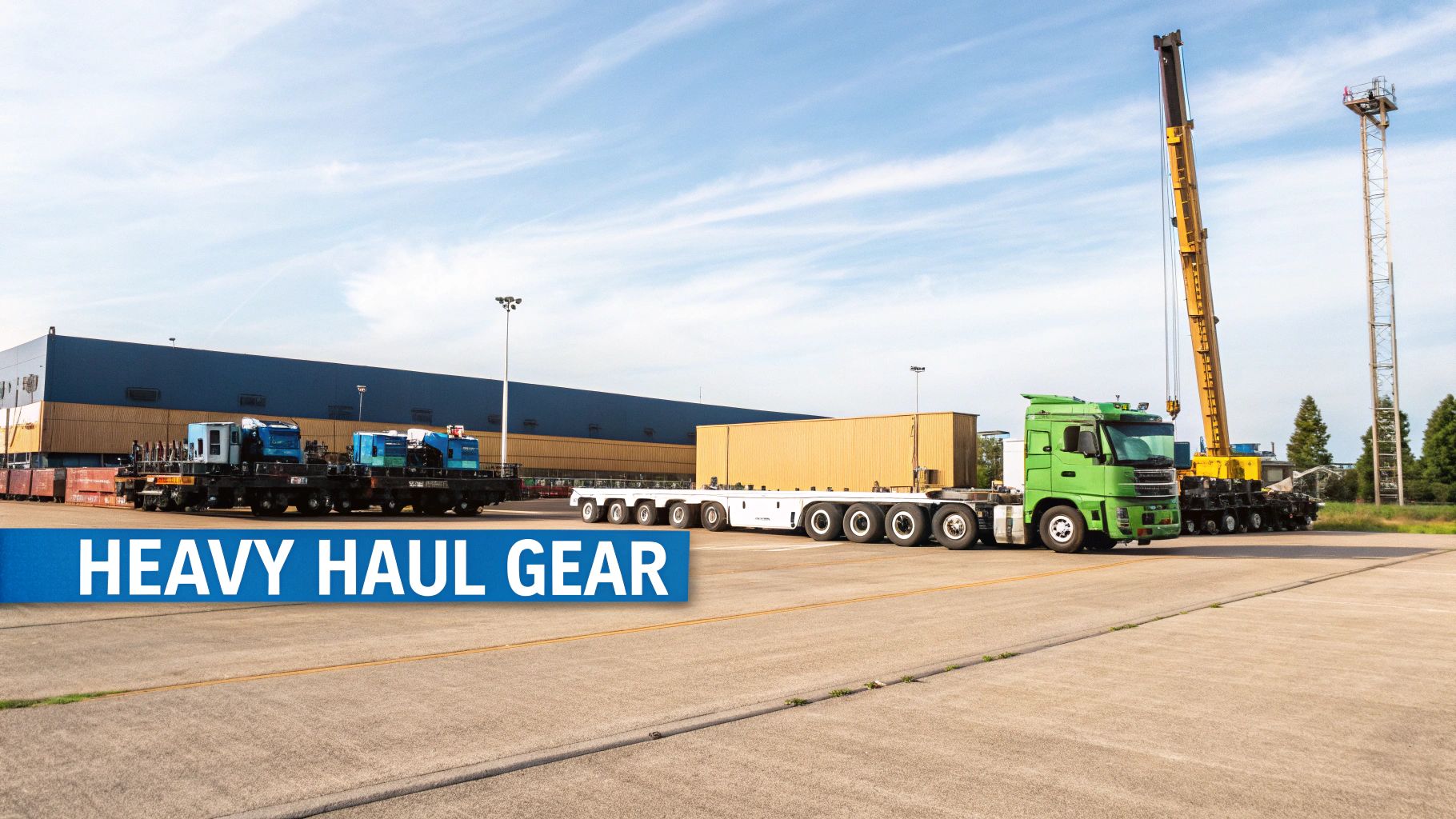
The success of any heavy haul operation hinges on having the right tools for the job. You wouldn’t use a family car to move a grand piano, and the same logic applies here—standard trucks just aren't built for the demands of industrial-scale cargo.
Making the right equipment choice is the bedrock of the entire transport project. It's not just about brute strength; it's about engineering a specific solution for your cargo's unique challenges, like its height, weight distribution, and loading requirements. The wrong choice can lead to damaged goods, blown deadlines, and potentially dangerous situations on the road.
The Workhorses of Heavy Haul Trailers
When it comes to heavy transport, specialized trailers are the real MVPs. Each type is a purpose-built machine designed to solve a different kind of logistical puzzle, whether that’s clearing a low bridge or spreading immense weight across enough axles to make a move legal. Knowing your options is the first step to a successful transport plan.
Here are a few of the most common types and their practical applications:
-
Lowboy Trailers: These are your go-to for anything tall, like excavators, combines, or large tractors. Their signature two-level deck drops down in the middle, allowing cargo to sit just inches off the ground. That small difference provides the critical clearance needed to safely navigate under bridges and overpasses.
-
Removable Gooseneck (RGN) Trailers: For equipment that can be driven on and off, RGNs are a game-changer. The entire front section, or "gooseneck," detaches from the trailer, dropping the front end to the ground to create a sturdy, built-in ramp. This eliminates the need for a crane, a significant operational advantage you can explore further in this guide to RGN trailer transport.
-
Self-Propelled Modular Transporters (SPMTs): These are in a league of their own. Forget trailers—think massive, multi-axle platforms run by a computer. They can be linked together in almost endless configurations to handle the most mind-boggling loads, like entire bridge sections or prefabricated building modules. SPMTs offer precision maneuverability that nothing else can match.
Choosing the right trailer is a critical decision based on the specific dimensions, weight, and loading requirements of the cargo. The table below outlines some of the most common options and their primary applications.
Comparison of Common Heavy Haul Trailers
| Trailer Type | Common Use Case | Typical Axle Configuration | Key Advantage |
|---|---|---|---|
| Lowboy | Tall equipment (e.g., excavators, bulldozers) | 2-4+ axles | Low deck height for vertical clearance |
| RGN | Drive-on/drive-off heavy machinery | 3-20+ axles | Detachable front creates a loading ramp |
| Step-Deck | Taller cargo that doesn't require a lowboy | 2-3 axles | More versatile than a flatbed |
| SPMT | Extremely large, heavy items (e.g., bridge sections) | 4-6 axle lines per module | Modular and self-propelled for precision |
Ultimately, the goal is to select a trailer that not only supports the weight but also distributes it correctly and allows for safe loading and transit.
Beyond the Trailer: The Essential Support Fleet
A heavy haul is never a solo mission. The main trailer is just the star of the show; it relies on a whole cast of supporting vehicles and gear to move safely and legally. This team is every bit as critical as the truck itself.
The escort vehicle isn't just a formality; it's the eyes and ears of the operation. Pilot car drivers are trained professionals who manage traffic, communicate with law enforcement, and provide the truck driver with critical real-time information about upcoming hazards.
This supporting cast often includes a combination of the following:
-
Pilot/Escort Vehicles: In most states, these are legally mandated for loads that exceed standard dimensions. They travel ahead of and behind the truck, warning other drivers, spotting low-hanging obstacles, and coordinating with police or transportation authorities.
-
Cranes and Rigging Gear: If your cargo can't be driven onto a trailer, you'll need a specialized crane service. This involves much more than just a crane—it requires certified operators, a meticulous lift plan, and the right rigging equipment to ensure a safe and balanced load.
-
Bucket Trucks: For exceptionally tall loads, sometimes the route itself needs a little help. Utility crews in bucket trucks may travel with the convoy to temporarily lift low-hanging power lines or traffic signals, literally clearing the path as the truck approaches.
The availability of this kind of equipment often mirrors broader economic trends. For instance, in the U.S. trucking industry, Class 8 truck orders are a good proxy for heavy haul capacity. These orders fell by 15.5% year-over-year in Q1 2025 and then dropped another 42.7% in Q2, signaling a slow and uneven market.
How to Manage Risk and Ensure Safety
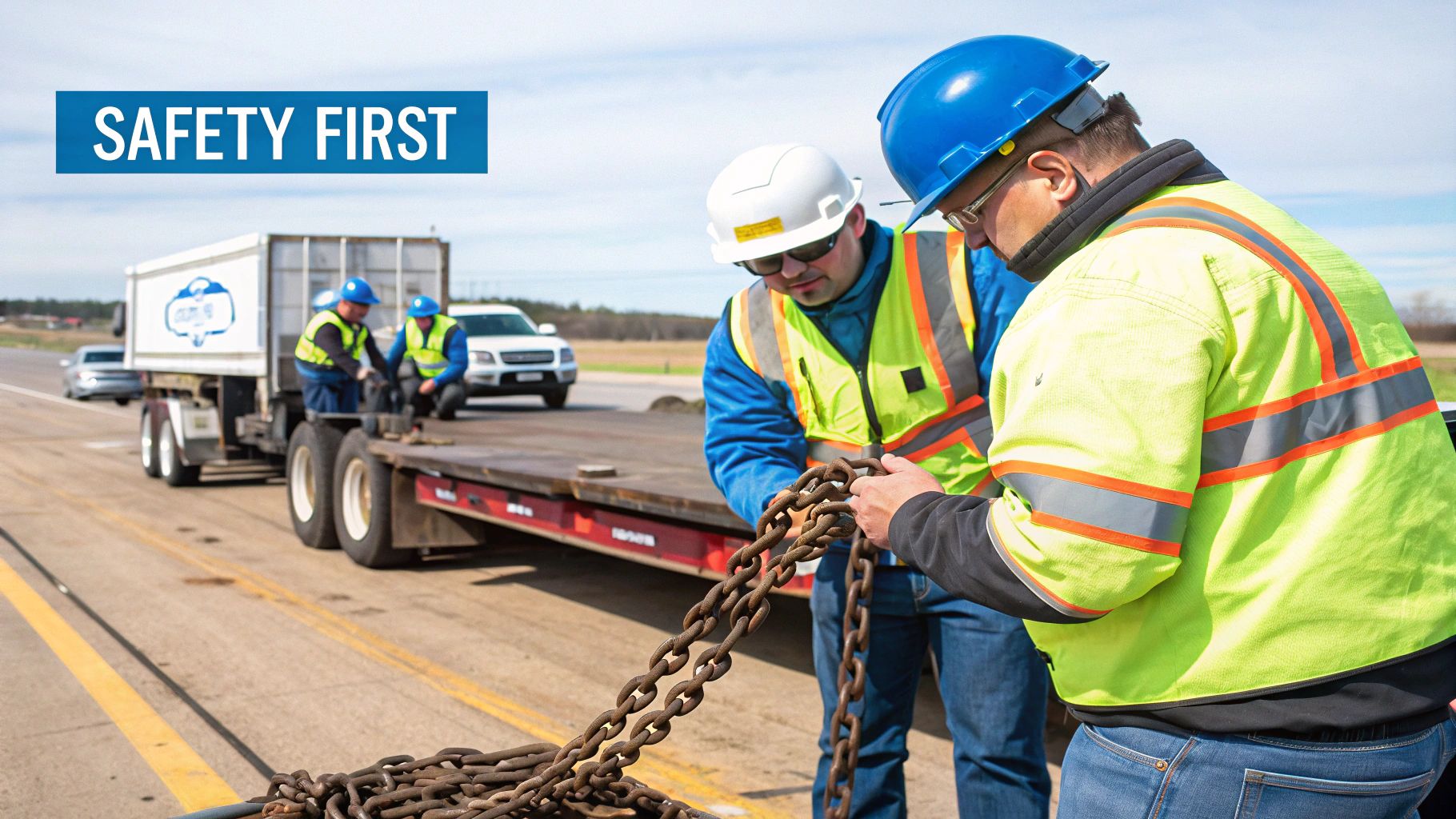
When you're moving something that weighs tens or even hundreds of tons, there's simply no room for error. A small mistake doesn't just damage the cargo—it can endanger your crew, the public, and critical infrastructure. That’s why risk management in heavy haul isn't just another box to check; it’s the foundation of the entire operation.
The process starts long before a single wheel turns. You have to think through everything that could go wrong. We usually split these risks into two buckets: operational and external. Operational risks are things you have a good deal of control over, like keeping your equipment in top shape or making sure your team is properly trained.
External risks, on the other hand, are the wild cards—severe weather, sudden road closures, or other drivers. A solid safety plan treats both with the same level of seriousness. It's about shifting your mindset from a reactive "what if?" to a proactive "when this happens, here's what we do."
Building Your On-Site Safety Protocol
This is where planning meets execution. On-site safety is about putting your careful plans into practice with clear, non-negotiable procedures. A proven protocol is your first and best line of defense against accidents.
An effective safety protocol rests on three core pillars:
- Rigorous Pre-Trip Inspections: This is more than a quick walk-around. The crew must inspect every chain, binder, and tie-down for signs of wear. They must confirm the trailer’s hydraulic and electrical systems are functioning perfectly and that every tire is inflated to the correct pressure.
- Proper Cargo Securement: This is a science, not guesswork. According to the FMCSA, most heavy equipment requires a bare minimum of four-point securement. Each tie-down must be rated for the cargo's full weight, and they must be placed strategically to prevent any movement—forward, backward, or side-to-side.
- Constant Communication: The driver, pilot car operators, and ground crew must be connected at all times. This means everyone knows the standard hand signals for loading, and there is a reliable radio system for calling out road hazards in real-time.
In heavy load logistics, the chain of safety is only as strong as its weakest link. A single frayed tie-down or a misunderstood command can undermine the most detailed route plan. Absolute diligence is the only acceptable standard.
Mitigating External Factors and Financial Risk
You can't stop a blizzard from rolling in, but you can plan for it. A truly comprehensive risk strategy accounts for these external threats and protects your financial stake with the right insurance.
For example, your contingency plan should already have pre-approved safe havens marked along the route—places where the convoy can pull over and wait out a storm. If another vehicle gets too close or someone interferes, the protocol should be to immediately contact local law enforcement, who should have already been briefed on the transport.
Insurance is your final safety net. Standard freight insurance just won't cut it for high-value, oversized cargo. You need a specialized policy that covers:
- Cargo Value: The policy must cover the full replacement cost of the equipment being moved, which can easily run into millions of dollars.
- Third-Party Liability: This is crucial. It protects you if your load damages property, like a bridge, guardrail, or utility pole.
- Delay Costs: Some specialized policies can even help cover the extra expenses that pile up if an insured event causes a major project delay.
At the end of the day, managing risk is about creating a deeply ingrained culture of safety. It's a commitment to meticulous planning, flawless execution, and open communication that keeps your cargo, your crew, and your reputation secure.
The Future of Heavy Load Transport
The world of heavy load logistics is on the brink of a massive shift. This isn't just about bigger trucks or stronger cranes; it’s a fundamental change driven by powerful new technologies and some very real economic pressures. To stay competitive, you can't just own the best equipment anymore. The future belongs to those who embrace smarter, safer, and more efficient ways of working.
This isn't some far-off prediction—it's happening today. For instance, operational expenses in heavy haul trucking are expected to climb by an average of 6% each year through 2025. With everything from diesel and maintenance to driver pay on the rise, fleet managers are being forced to find better solutions. You can dig deeper into these heavy haul trucking trends and cost projections.
The Rise of Intelligent Transport Systems
Picture this: a heavy haul truck that flags a potential engine problem days before it could cause a breakdown. Or a route that automatically reroutes itself to avoid an unexpected bridge closure. This isn't science fiction; it's the reality being built with telematics and the Internet of Things (IoT).
IoT sensors, built right into trucks and trailers, are now feeding a constant stream of live data on everything from engine diagnostics and tire pressure to the exact temperature of the cargo. This allows a shift from the old "fix it when it breaks" model to predictive maintenance, which is a total game-changer for transport reliability.
Here's how this technology translates into real-world benefits:
- Real-Time Tracking: GPS and telematics provide dispatchers and clients a live, transparent view of the entire journey, simplifying coordination for offloading crews and equipment.
- Preventive Diagnostics: IoT sensors constantly monitor critical systems, alerting crews to potential trouble—like an overheating engine or low hydraulic fluid—long before it becomes a crisis that leaves a multi-million-dollar load stranded on the roadside.
- Safety Monitoring: It is now possible to track driver behavior like harsh braking or speeding. This isn't about playing "big brother"; it's about gathering objective data to improve safety training and reduce risk across the fleet.
The future of heavy load logistics isn't about stronger trucks; it's about smarter ones. Data is becoming the most valuable asset, transforming guesswork into precise, predictive decision-making that saves time, money, and improves safety.
AI and Automation in Route Optimization
Artificial intelligence (AI) is completely rewriting the rules of route planning. While a human planner might juggle a handful of routes, an AI algorithm can sift through thousands of possibilities in seconds.
It processes a staggering amount of information—live traffic, weather forecasts, and state-by-state permit rules—to find the absolute best path. This means AI can design routes that are not just the fastest, but also the most fuel-efficient and safest. It can sidestep steep hills that guzzle fuel or steer clear of intersections with a history of accidents. This kind of deep optimization was simply out of reach before and is already delivering major cost savings.
The Push Toward Electric and Alternative Powertrains
The double whammy of rising fuel costs and a global focus on sustainability is pushing the industry toward electric and alternative fuels. While a fully electric heavy hauler isn't something you'll see every day just yet, the technology is moving at an incredible pace.
The main challenges, like battery range and the lack of charging infrastructure, are being tackled head-on. The payoff will be huge: drastically lower fuel bills, less maintenance thanks to simpler engines, and zero emissions. We're also seeing exciting progress with hydrogen fuel cells, another clean alternative on the horizon. For any business in heavy load logistics, monitoring these technologies isn't just a good idea—it's essential for staying competitive in the years to come.
Answering Your Heavy Haul Questions
Even the most seasoned project managers run into questions when coordinating a heavy haul. The sheer number of moving parts can be a lot to handle. Here, we'll tackle some of the most common questions we hear, giving you straight, actionable answers based on our experience.
What Goes into a Heavy Haul Quote?
People often assume the cost is just about mileage, but that's only a small piece of the puzzle. The final price tag is a blend of several critical factors. A comprehensive quote must account for the exact weight and dimensions of your cargo, the complexity of state permits, the number of escort vehicles required, and any special handling needs, such as cranes for loading and unloading.
Planning Timelines and Finding the Right Crew
How far in advance should I plan a heavy haul?
It really depends on the load. For a standard oversized load that's only crossing a state or two, you can usually get everything arranged in 2-3 weeks. But if you're dealing with a "superload" or a route that spans multiple states with different regulations, you need to start the conversation 1-2 months ahead. That lead time is crucial for navigating the complex permitting and detailed route surveys without hitting expensive snags.
The biggest bottleneck in heavy haul today isn't the equipment or the permits—it's the people. Finding qualified drivers and experienced crews is a huge challenge and can directly impact your project's timeline.
What do escort vehicles actually do?
Think of escort vehicles (or pilot cars) as the secret service for your cargo. Their main job is to ensure public safety and protect the load. They scout ahead, warning other drivers on the road and communicating directly with the truck driver about potential hazards like low-hanging power lines, sharp turns, or narrow bridges. They are the eyes and ears of the entire operation, making sure the convoy moves smoothly and safely from start to finish.
The struggle to find qualified staff is a real and growing issue. Industry-wide, 69% of logistics managers say that a lack of drivers is hampering their ability to keep up with demand. You can find more details on this and other logistics management trends on cleo.com. This shortage makes it more important than ever to lock in your experienced crew well in advance.
At We Will Transport It, this is our world. We navigate these complexities daily. Our team of logistics pros takes care of everything from the initial route planning and permitting to the on-the-ground coordination, making sure your heavy equipment gets where it needs to go, safely and on time.
Ready to get your heavy load moving? Start your transport plan by visiting us at https://www.wewilltransportit.com.

